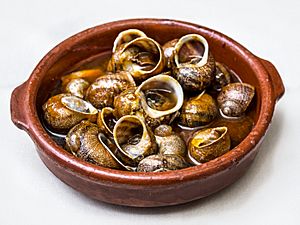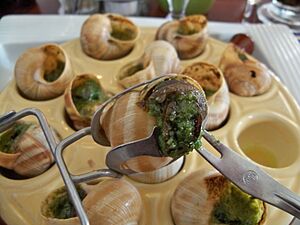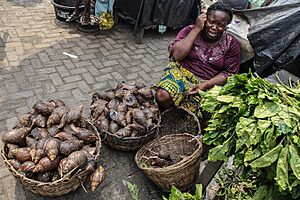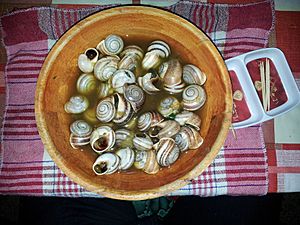Snails as food facts for kids

Snails are eaten in many parts of the world, like the Mediterranean region, Africa, and Southeast Asia. But in some cultures, eating snails is not allowed or is seen as unusual. In English, edible land snails are often called escargot, which is the French word for 'snail'. Raising snails for food is called snail farming or heliciculture. People have been eating snails for a very long time, with traditions going back to ancient times in many cultures.
Snails are usually collected after it rains. Then, they are "purged," which means they fast (don't eat) for a few days. In the past, snails were mostly eaten from April to June. But now, thanks to modern snail farming, you can find them all year round. Snail farming is popular in Spain, France, and Italy, which are also countries with a long history of cooking with snails. Even though snails were once seen as "poor people's food," they are now considered a delicacy (a special, rare food) by famous chefs, especially in haute cuisine (fancy French cooking).
Contents
What Does Escargot Mean?
The word escargot (pronounced es-kar-GO) comes from the French word for snail. It was first used in English around 1892. The French word itself comes from older words in Provençal and Old French, and even further back from Vulgar Latin and Classical Latin. These words eventually came from the Ancient Greek word konchylion, which meant "edible shellfish" or "oyster." Some experts think the word might also have been influenced by words related to the scarab beetle.
A Brief History of Snails as Food
Scientists aren't sure exactly when humans started eating snails. But old discoveries suggest it happened even before people learned to hunt! Many broken snail shells have been found in the Franchthi Cave in Greece, dating back to 10,700 BCE. Eating snails was probably easy because they are simple to catch and raise. Unlike hunting big animals, you don't need weapons or dogs, and it's much safer. Also, snails are easy to feed and can be raised in large numbers.
Many ancient sites in Iraq and Iran also show snail shells that were likely food remains. In the Maghreb region (North Africa), there's strong evidence of land snail eating from 20,000 years ago. Outside the Mediterranean, snail remains have been found in the Caribbean, Peru, Texas, East Africa, and the Philippines.
Snails in Ancient Rome
The Romans thought of escargots as a special food for rich people, as written by Pliny the Elder. A Roman snail farmer named Quintus Fulvius Lippinus is often called the "father" of snail farming. He set up a place in Tarquinia to study how to raise different animals, including snails. He was famous for his huge snails, which he brought from places like Illyria to Africa. He fed them a special fatty diet to make them bigger, then sold them in Rome. His snails became very popular among the Roman upper class.
In De re coquinaria, one of the most complete Roman cookbooks, there are four recipes for snails. Snail shells have also been found in the Roman city of Volubilis in modern-day Morocco, showing they were eaten there too.
Snails in the Modern Age
During the Modern Age, Pope Pius V, who loved eating snails, decided they should be considered "fish." This allowed people to keep eating them during Lent, a time when meat is traditionally not eaten. He even famously said, Estote pisces in aeternum! ('You will be fish forever!').
In Spain, eating snails continued to be popular. A book called Libro del arte de cozina by Diego Granado, a chef for the Spanish royal family, had a whole section on snails. It explained how to clean them and gave many recipes. This book was published in 1614 in Lérida, a city in Catalonia famous for its snail dishes.
Types of Edible Snails
Not all land snails can be eaten. Many are too small to be worth cooking, and their taste can be very different between species.
Here are some common types of snails that people eat:
- From the Helix group:
- Helix lucorum, also known as the European snail.
- Helix pomatia, called the Roman snail or Burgundy escargot. This is the most eaten type in France.
- Helix salomonica
- From the Cepaea group:
- Cepaea nemoralis, the grove snail, known as rayado ('striped' snail) in Spain.
- Cepaea hortensis, the white-lipped snail.
- From the Otala group:
- Otala punctata, known as cabrilla in Spain, which are larger.
- Otala lactea, the Spanish snail.
- From the Pomacea group:
- Pomacea canaliculata, the apple snail. It's from South America but widely eaten in Asia, even though it's an invasive species there.
- Pomacea urceus, known as guarura in Colombia and Venezuela.
- Other types:
- Buccinum undatum, the common whelk (a sea snail).
- Cantareus apertus, also called the garden snail.
- Cornu aspersum, another common garden snail, known as petit-gris in France.
- Elona quimperiana, known as escargot de Quimper in France.
- Lissachatina fulica, the giant African snail.
- Persististrombus latus, a sea snail known by different names in Africa.
- Pachychilus sp., eaten by the Maya people.
Snail Nutrition and Health Benefits
Quick facts for kids Nutritional value per |
|
|---|---|
| Energy | 377 kJ (90 kcal) |
|
2
|
|
| Sugars | 0 |
| Dietary fibre | -- |
|
1.4
|
|
|
Protein
|
16.1
|
| Vitamins | Quantity
%DV†
|
| Vitamin A equiv. |
13%
100 μg |
| Thiamine (B1) |
1%
0.01 mg |
| Riboflavin (B2) |
10%
0.12 mg |
| Niacin (B3) |
9%
1.4 mg |
| Vitamin B6 |
10%
0.13 mg |
| Vitamin B12 |
21%
0.5 μg |
| Vitamin C |
0%
0 mg |
| Vitamin D |
0%
0 IU |
| Vitamin E |
33%
5 mg |
| Vitamin K |
0%
0.1 μg |
| Minerals | Quantity
%DV†
|
| Calcium |
1%
10 mg |
| Copper |
20%
0.4 mg |
| Iron |
27%
3.5 mg |
| Magnesium |
70%
250 mg |
| Phosphorus |
39%
272 mg |
| Potassium |
13%
382 mg |
| Selenium |
39%
27.4 μg |
| Sodium |
5%
70 mg |
| Zinc |
11%
1 mg |
| Other constituents | Quantity |
| Water | 79.2 |
| †Percentages estimated using US recommendations for adults. | |
Snail meat is a healthy choice because it's low in calories and fat. It's also a good source of protein (about 10% to 19%). Snails are mostly water (about 82%) and contain important minerals like magnesium and iron. They also have calcium, phosphorus, potassium, and sodium. Snails are rich in vitamin B3 and selenium. Eating snails can provide a lot of the daily recommended amount of these nutrients.
Because snails have a lot of iron, they are good for people who have iron-deficiency anemia. Their low fat content means they provide healthy omega-3 fatty acids. Eating snails regularly can help with mood, strengthen your nervous and immune systems, prevent heart problems, and help your thyroid gland work well.
How to Prepare and Cook Snails
Before snails can be cooked, they need to be cleaned to remove any dirt or impurities. This cleaning process is called purgado in Spanish. It involves keeping the snails alive for several days without food, or sometimes feeding them only flour. The flour method helps clean out their digestive system. In the past, snails were often hung in mesh bags so they couldn't escape. It's recommended to let them fast for at least eight days, or even ten to twelve, then wash them very well. Any snails that die during this cleaning process should be thrown away.
Cooking Snails: The Basics
First, the slimy coating on the snails needs to be removed. This is done by washing them many times with water, either in a colander under running water or in a pot. Then, they are washed again with salt water, as the salt helps to cut through the slime. After being cleaned and washed, the snails are put into a pot with cold water and salt. When they start to come out of their shells as the water heats up, the heat is turned up high. They are then cooked for about 15 minutes. After this, they are ready to be added to a stew, sauce, or any other recipe. This step is sometimes called engañar ("cheating") the snail in Spain, because they are tricked into coming out of their shells before the heat is fully turned up.
How to Eat Snails

In bars where snails are served as a tapa (a small snack), they are often given with toothpicks. This is a simple way to get the snail meat out of the shell. A normal serving for one person is usually about 25 to 30 snails. In fancy haute cuisine restaurants, snails are eaten using special tools: a pince à escargot (tongs to hold the shell) and a fourchette à escargot (a small fork to pull out the snail).
Snails can be cooked in many different ways. They can be made into stews, baked, or cooked a la gormanta or a la brutesque. In the city of Lleida, Spain, snails are a key ingredient in many traditional dishes. They are often mixed with other meats, such as snails with pig's feet, rabbit, chicken, or even lobster and shrimp.
Snails as Food Around the World
African Countries

In countries like Cameroon, Ghana, and Nigeria, people eat larger types of African snails. In Equatorial Guinea, a giant sea snail called bilolá (Persististrombus latus) is popular. It's eaten stewed or sautéed. In Cape Verde, this same snail is called búzio cabra and is grilled on skewers.
Mediterranean Region
Eating snails is a long-standing tradition in many Mediterranean countries. This includes Andorra, Spain, France, Italy, and Portugal in Europe, and Algeria, Morocco, and Tunisia in Africa. The Cornu aspersum snail is the most common type found and eaten in this area.
In French cuisine, snails are typically cleaned, cooked (often with garlic butter, chicken stock, or wine), and then put back into their shells with the butter and sauce to be served. Other ingredients like garlic, thyme, parsley, and pine nuts might be added. Special tongs and forks are usually provided. Snails are served on metal trays with spaces for six or twelve snails.
In Cretan cuisine (from the island of Crete), snails are first boiled in white wine with bay leaves, celery, and onion. Then, they are coated in flour and fried with rosemary and vinegar.
In Maltese cuisine, snails (called bebbux in Maltese) are simmered in red wine or ale with mint, basil, and marjoram. They are cooked and served in their shells.
In Moroccan cuisine, snails, known as Ghlal, are a popular street food. They are cooked in a pot with hot water, special spices, and herbs. After cooking, Moroccan snails are served hot in small bowls with their broth. People often enjoy them in winter because they are believed to help with colds or joint pain.
The city of Lérida in Catalonia, Spain, is famous for its snail culture. Since 1980, it has hosted the L'Aplec del Caragol festival, which attracts about 300,000 visitors during a weekend in May.
Southeast Asia
Snails are eaten in Cambodia, the Philippines, Indonesia, Laos, Malaysia, Thailand, and Vietnam. In Indonesia, snails from rice fields are often fried on skewers, a dish called sate kakul. They can also be grilled.
In the western part of Java island, rice field snails are called tutut and are eaten with different sauces, like curry.
Other Regions
- The Terai region in Nepal.
- Northeast India, including the states of Manipur, Tripura, and Nagaland. In Nagaland, snails are prepared with a fermented soybean product called axone and pork meat. In Manipur, they are called 'tharoi'.
- North India, in the states of Uttar Pradesh and Bihar. In the Mithila region of Bihar, they are called 'doka'. Elsewhere in Bihar and eastern Uttar Pradesh, they are called 'ainthi'. They are boiled, and the meat is taken out to make a curry, usually eaten with rice.
- There is a growing demand for snails in South America, especially in Argentina, Chile, Peru, and Uruguay.
See also
 In Spanish: Caracoles (gastronomía) para niños
In Spanish: Caracoles (gastronomía) para niños



